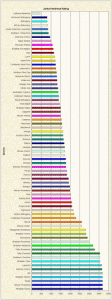Janka Scale

How do you rate the hardness of a wood floor? Wood is rated by it’s hardness on a commonly accepted rating called the “Janka Hardness Scale“. The Janka Scale was created in 1906 by Gabriel Janka. Gabriel was an Austrian wood researcher. His “scale” was accepted by the American Society for Testing and Materials (ASTM) in 1927 and has been the industry standard now for almost 40 years.
The Janka Scale rates the relative hardness of wood. The higher the number the harder the wood. Janka measures the amount of force it takes to embed a .444 inch steel ball into the wood until half the diameter of the ball is embedded.
This should only be used as a general guide when comparing various species of wood flooring. Depending on where the wood is harvested, the grain of wood used, this number can vary. The plank construction and finish are also important considerations when determining the durability and ease of maintenance of your hardwood floor.
So what is a good Janka rating for a floor? A rating of 1000 or higher is the standard for wood flooring. Oak is a common type of wood flooring used today. White oak has a rating of 1360 and red oak rates 1260.
